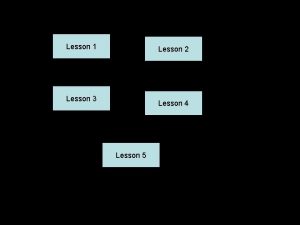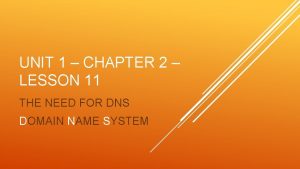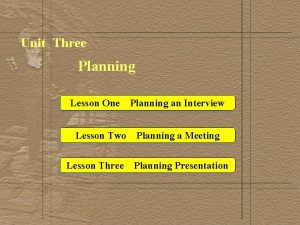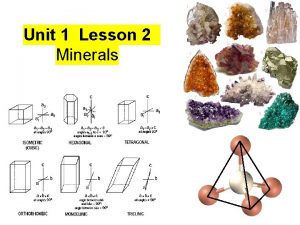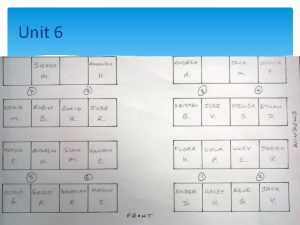UNIT 1 CHAPTER 2 LESSON 12 THE NEED































- Slides: 31

UNIT 1 – CHAPTER 2 – LESSON 12 THE NEED FOR DNS DOMAIN NAME SYSTEM

Mrs. P is not here today, so you as a class have to do this lesson together.

Vocabulary Alert DNS - DOMAIN NAME SYSTEM - The service that translates URLs to IP addresses.

PICK UP THESE ITEMS: 1. ONE (ONLY ONE) IP ADDRESS LABEL 2. WORKSHEET FOR NAMES AND ADDRESSES 3. ACTIVITY GUIDE – DNS PARTNER QUESTIONNAIRE 4. ACTIVITY GUIDE – RESEARCH: DNS IN THE REAL WORLD 5. HOMEWORK FOR LESSON 12

The core idea of this lesson occurs in the unplugged activity that kicks off the lesson, in which students try to keep track of IP addresses that had been randomly assigned to each student in the class, while at the same time the students’ IP address changes. This leads to identifying the need for an authoritative system for name-to-address mappings, known as the Domain Name System or DNS.

You will then briefly experiment with a DNS protocol in the Internet Simulator. The activity is similar, in that you will have to grapple with IP addresses changing in real time and use the built in DNS protocol to resolve the issues.

The lesson ends with you doing some rapid research about DNS and some of its vulnerabilities, particularly what are known as Denial of Service Attacks.

Purpose The basic purpose of this lesson is to show some of the challenges solved, and created by, DNS. At its core, the DNS is "simply" a hierarchical system of computers and databases, that maps IP addresses to domain names. It enables Internet users to connect human-language locations on the Internet with numeric addresses used by IP. While distributed and hierarchical, it can be treated in the abstract as a centralized registry of locations on the Internet, allowing users to quickly find locations they are looking for and register themselves so that others may find them.

USE THE IP ADDRESSES and THE WORKSHEET. For the next 5 minutes, your goal is to complete an accurate list of IP addresses and names for all students in the room. You may only talk to one person at a time, but you may exchange as much information with that person as you want. IMPORTANT: From time to time, get a NEW IP Address from the collection of addresses. GO!

Why did we switch your IP addresses? This simulates the fact that a computer’s IP address does not stay the same. For example, a person’s IP address on their phone changes quite frequently as they move around throughout their day and their phone tries to connect to the Internet from different locations.

Do you think the system we just simulated is an efficient way of collecting IP addresses? Are there any inefficiencies you observe? How could it be made better? A central list would be better, and the Internet has a system for that.

Open Code Studio and connect to the Internet Simulator and use the DNS Partner Questionnaire - Activity Guide. The new configuration of the simulator includes a DNS server. A DNS server now appears attached to every router.

We no longer can see anybody’s IP address. To get an IP address, we have “ask” the DNS server using a text-based protocol. Try this: see how to send a request to the DNS for someone’s address. Try the DNS protocol to get the address of someone who is attached to their router.


After the DNS has returned an IP address, you can type that IP address into the “To” field, enter a message, and then press “send. ”

You are going to interview/have a conversation with a classmate using only the Internet Simulator. We’ve created a list of interview questions (on the back) and you should both jot down each other’s responses.

To find the person, you will have to ask the DNS for her IP address. When you have retrieved the IP address, start the interview.

HOWEVER…. As you’re working, you both MUST disconnect and reconnect from the simulation. This is to simulate changing IP addresses. Do this at least twice during the interview.

Even though your IP address will change, your hostname will stay the same, so you’ll need to re -join a router and ask the DNS for your partner’s new IP address in order to continue having your conversation!

You may remember (from the IP/DNS video that we saw several lessons ago) that you learned about the Internet system (v DNS) for sharing names and IP addresses. Let's watch that section again! Watch the DNS portion of this video as a transition to the next activity. Video: IP and DNS - start at 4: 12

Hopefully we all get the basic idea: the DNS is the large-scale system that translates humanreadable web addresses into their numeric IP addresses so that computers can communicate.

This system however was not designed to be secure and that has resulted in some major security incidents over time. You're now going to learn about some of them and how they work.

Get in groups of 3 -4 people to complete readings. Use: Research: DNS in the Real World - Activity Guide, one copy per student. Each person in the group picks an article about DNS and DDo. S attacks The list of articles can be found on the first student page (bubble 1) on Code Studio for this lesson. DON’T ALL PICK THE SAME ARTICLE! Complete the first page of the worksheet

So the front page is about your article that you read. Flip the paper over, and share with your group members Key points about their articles. Find other people in the room who have different articles, and add those points. Try to get info on as many articles as you can.

WRAP UP The Internet is basically a network of computers sending messages to request information and computers replying to messages to satisfy information requests. Computers need to identify “from” and “to” for all messages. Computer speak in numbers, not names.

All communication online is via IP addresses. However, we are more familiar with human readable names, most notably URLs like “Code. org” or “Google. com. ”

We need a way to translate human-readable names into IP addresses.

It is inefficient for everyone on the Internet to maintain a table of IP addresses.

The DNS is NOT centralized, but it's not completely autonomous and distributed like routing, either. There is a hierarchical system of servers to maintain an authoritative table that, like a phone book, others can consult when they need to find an address.

A properly functioning DNS system requires collaborative efforts among all users to ensure it is up to date and accurate.

Finish up in the Code Studio with Assessments and Reflections. Don’t forget to do your homework! I will see you Monday!
 Hyp opp adj
Hyp opp adj Unit 10, unit 10 review tests, unit 10 general test
Unit 10, unit 10 review tests, unit 10 general test Overall state of well being or total health
Overall state of well being or total health Hát kết hợp bộ gõ cơ thể
Hát kết hợp bộ gõ cơ thể Ng-html
Ng-html Bổ thể
Bổ thể Tỉ lệ cơ thể trẻ em
Tỉ lệ cơ thể trẻ em Gấu đi như thế nào
Gấu đi như thế nào Tư thế worm breton là gì
Tư thế worm breton là gì Hát lên người ơi alleluia
Hát lên người ơi alleluia Các môn thể thao bắt đầu bằng từ đua
Các môn thể thao bắt đầu bằng từ đua Thế nào là hệ số cao nhất
Thế nào là hệ số cao nhất Các châu lục và đại dương trên thế giới
Các châu lục và đại dương trên thế giới Công thức tính độ biến thiên đông lượng
Công thức tính độ biến thiên đông lượng Trời xanh đây là của chúng ta thể thơ
Trời xanh đây là của chúng ta thể thơ Mật thư anh em như thể tay chân
Mật thư anh em như thể tay chân 101012 bằng
101012 bằng độ dài liên kết
độ dài liên kết Các châu lục và đại dương trên thế giới
Các châu lục và đại dương trên thế giới Thể thơ truyền thống
Thể thơ truyền thống Quá trình desamine hóa có thể tạo ra
Quá trình desamine hóa có thể tạo ra Một số thể thơ truyền thống
Một số thể thơ truyền thống Cái miệng nó xinh thế
Cái miệng nó xinh thế Vẽ hình chiếu vuông góc của vật thể sau
Vẽ hình chiếu vuông góc của vật thể sau Biện pháp chống mỏi cơ
Biện pháp chống mỏi cơ đặc điểm cơ thể của người tối cổ
đặc điểm cơ thể của người tối cổ Thứ tự các dấu thăng giáng ở hóa biểu
Thứ tự các dấu thăng giáng ở hóa biểu Vẽ hình chiếu đứng bằng cạnh của vật thể
Vẽ hình chiếu đứng bằng cạnh của vật thể Fecboak
Fecboak Thẻ vin
Thẻ vin đại từ thay thế
đại từ thay thế điện thế nghỉ
điện thế nghỉ
































